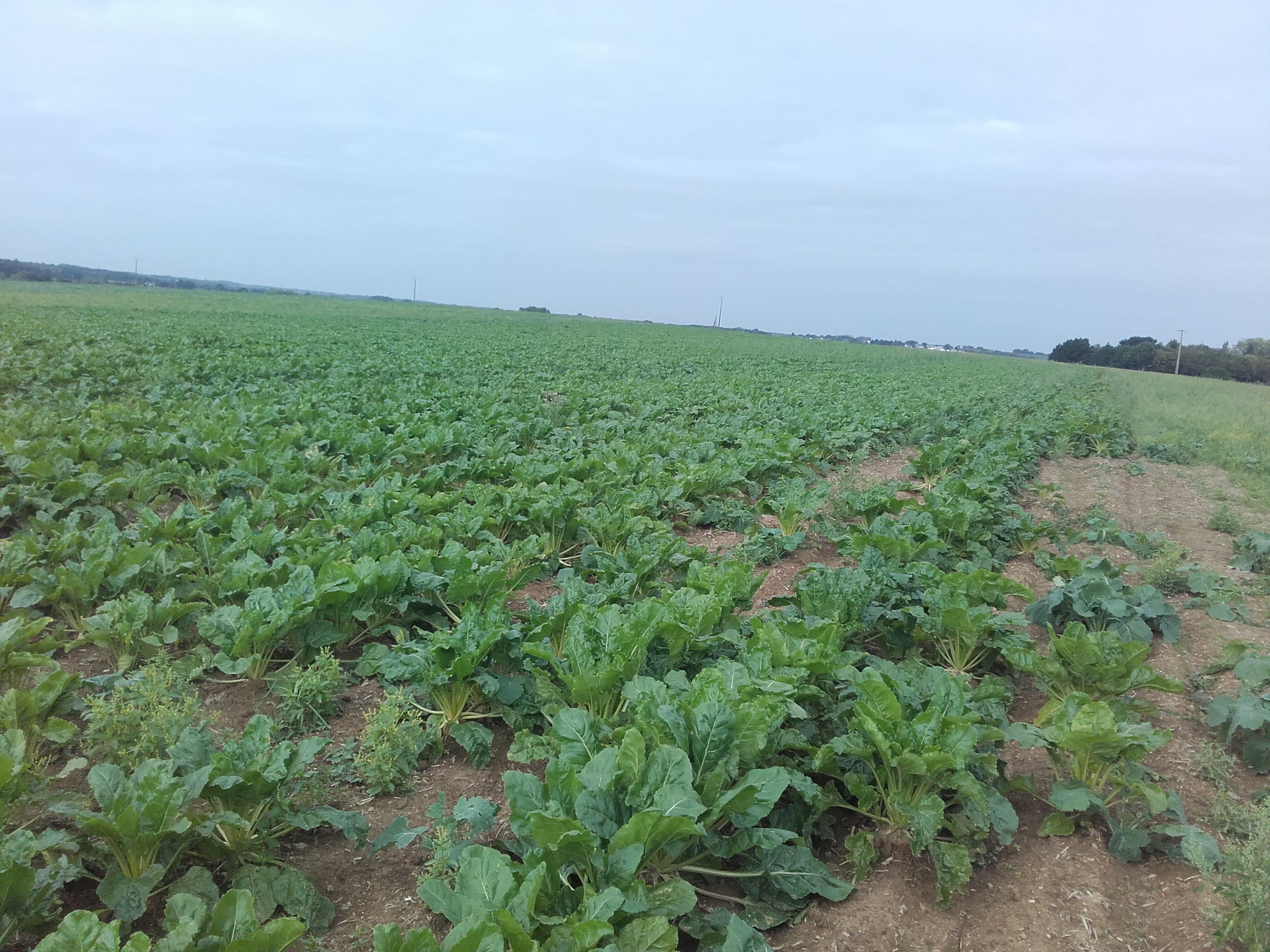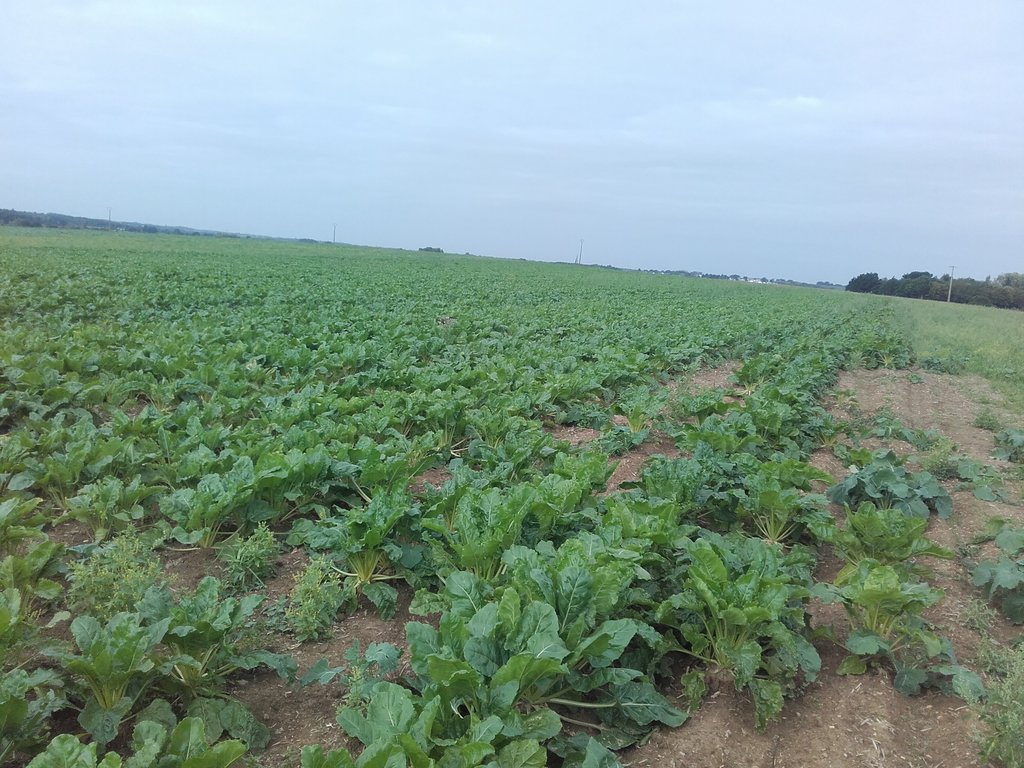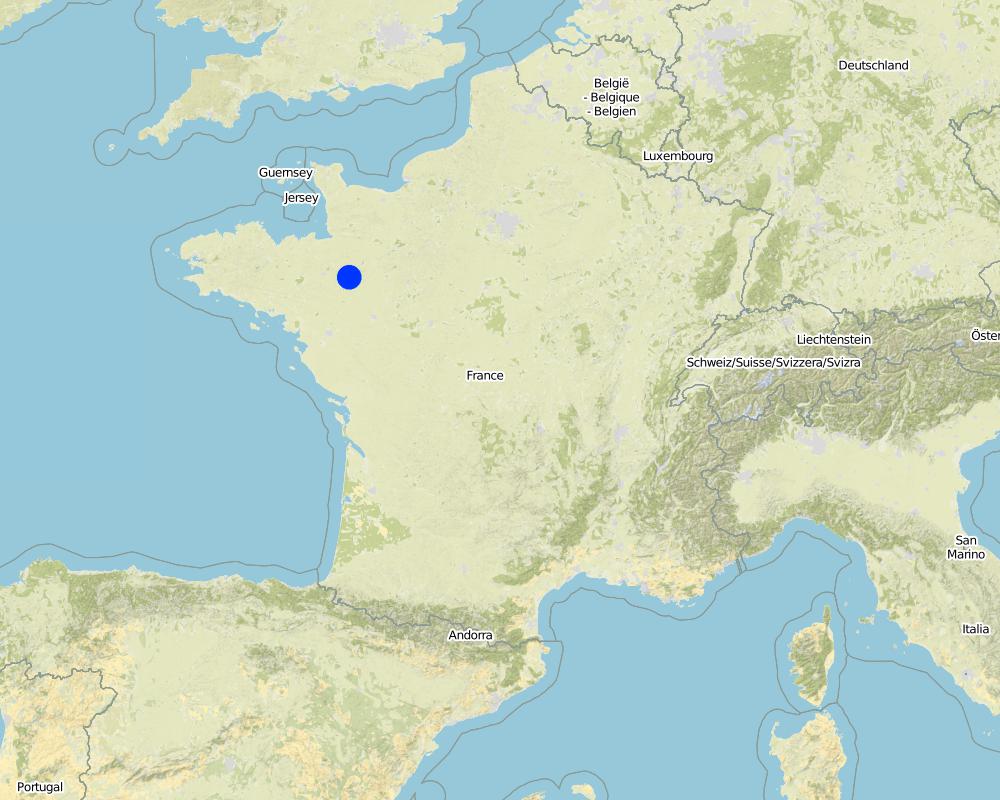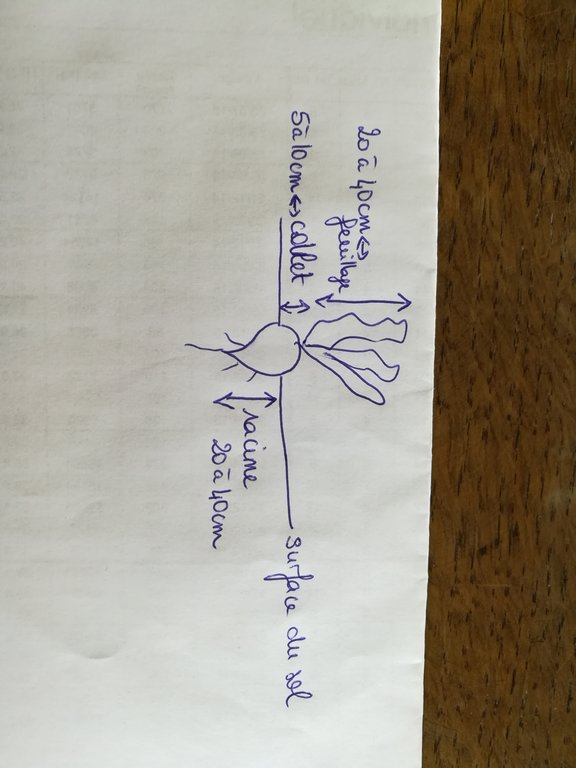Les Betteraves dans l'alimentation du bétail [France]
- Creation:
- Update:
- Compiler: Julie Lemesle
- Editor: –
- Reviewers: Gudrun Schwilch, Ursula Gaemperli, Alexandra Gavilano
technologies_3228 - France
View sections
Expand all Collapse all1. General information
1.2 Contact details of resource persons and institutions involved in the assessment and documentation of the Technology
Name of project which facilitated the documentation/ evaluation of the Technology (if relevant)
Interactive Soil Quality assessment in Europe and China for Agricultural productivity and Environmental Resilience (EU-iSQAPER)1.3 Conditions regarding the use of data documented through WOCAT
The compiler and key resource person(s) accept the conditions regarding the use of data documented through WOCAT:
Ja
1.4 Declaration on sustainability of the described Technology
Is the Technology described here problematic with regard to land degradation, so that it cannot be declared a sustainable land management technology?
Nee
2. Description of the SLM Technology
2.1 Short description of the Technology
Definition of the Technology:
La betterave est un légume racine riche en sucre et en cellulose utilisé dans l'alimentation du bétail.
2.2 Detailed description of the Technology
Description:
1. La culture de la betterave est utilisées sur l'exploitation agricole laitière en agriculture biologique. Les champs de betteraves éxaminés dans cette recherche sont situés dans la Bretagne dans une zone climatique océanique avec un sol bon à moyen et des moyens agricoles opérationnels facilement accessibles.
2. La betterave rentre dans une rotation de culture. Dans le cas présent, l'agriculteur réalise sa rotation avec une prairie, maïs ensilage et mélange céréalier. Dans la betterave, c'est la partie racine qui est utilisée pour l'alimentation des ruminants. Ce fourrage est riche en glucides solubles (de 60 à 70% en sec) et contient environ 8% de cellulose digestible. La digestibilité de la betterave est très élevée et ce fourrage est un aliment très énergétique.
3. La betterave est la principale source d'énergie dans l'alimentation hivernale des vaches laitières.
4. La culture de la betterave est conduite en deux phases principales : la première correspond au semis des plants de betteraves, la seconde correspond à la transplantation des plants en plein champ. Cette conduite de la culture en deux phases permet de minimiser la concurrence par les adventices, atout majeur en agriculture biologique. En conventionnel, les herbicides permettent de semer directement la betterave en plein champ et de se passer de la première étape. Une fois à maturité, la betterave peut être pâturée (assez rare) ou récoltée. Dans le cas d'une récolte, différents outils sont utilisés de manière à effeuiller les plants de betterave et les arracher du sol.
5. En agriculture biologique, tout comme en conventionnel, la culture de la betterave permet d'assurer un bon rendement en fourrage énergétique (20 tMS/ha contre 13 tms/ha en moyenne pour du maïs ensilage). Par ailleurs, cela permet la diversification de la rotation.
6. Les exploitants aiment la diversification de la rotation qu'apporte la betterave tout comme l'assurance d'un rendement. ils détestent la difficulté à gérer les adventices dans cette culture, les difficultés de récolte (résidus de terre), les difficultés de stockage et de distribution pour les animaux et le fait que cette culture déstructure la couche superficielle du sol.
2.3 Photos of the Technology
2.5 Country/ region/ locations where the Technology has been applied and which are covered by this assessment
Country:
France
Region/ State/ Province:
Ille et Vilaine/Bretagne/France
Specify the spread of the Technology:
- evenly spread over an area
If precise area is not known, indicate approximate area covered:
- < 0.1 km2 (10 ha)
Comments:
gaec de la branchette
Map
×2.6 Date of implementation
If precise year is not known, indicate approximate date:
- less than 10 years ago (recently)
2.7 Introduction of the Technology
Specify how the Technology was introduced:
- through land users' innovation
Comments (type of project, etc.):
Très fréquent à la fin de la seconde guerre mondiale, puis arrêt de l'usage. Enfin, réemployé depuis une quinzaine d'année.
3. Classification of the SLM Technology
3.1 Main purpose(s) of the Technology
- improve production
- create beneficial economic impact
3.2 Current land use type(s) where the Technology is applied
Land use mixed within the same land unit:
Nee

Cropland
- Annual cropping
Annual cropping - Specify crops:
- cereals - other
- cereals - maize
- vegetables - root vegetables (carrots, onions, beet, other)
Number of growing seasons per year:
- 1
Is crop rotation practiced?
Ja
3.4 Water supply
Water supply for the land on which the Technology is applied:
- rainfed
3.5 SLM group to which the Technology belongs
- rotational systems (crop rotation, fallows, shifting cultivation)
- integrated crop-livestock management
3.6 SLM measures comprising the Technology

agronomic measures
- A1: Vegetation/ soil cover
3.7 Main types of land degradation addressed by the Technology

physical soil deterioration
- Pc: compaction
- Pk: slaking and crusting
3.8 Prevention, reduction, or restoration of land degradation
Specify the goal of the Technology with regard to land degradation:
- not applicable
4. Technical specifications, implementation activities, inputs, and costs
4.1 Technical drawing of the Technology
Technical specifications (related to technical drawing):
La betterave est une plante racine avec un feuillage de 20 à 40 cm de hauteur et une racine sortant légèrement de terre (de 5-10cm) pour atteindre 20 à 40 cm de profondeur dans le sol.
Pour une exploitation facilité en agriculture biologique, la betterave est plantée en inter-rang d'environ 50 cm
Author:
Julie Lemesle
Date:
27/10/2017
4.2 General information regarding the calculation of inputs and costs
Specify how costs and inputs were calculated:
- per Technology area
Indicate size and area unit:
hectare
other/ national currency (specify):
euros
Indicate average wage cost of hired labour per day:
115 euros
4.5 Maintenance/ recurrent activities
| Activity | Timing/ frequency | |
|---|---|---|
| 1. | préparation du sol | printemps |
| 2. | plantation | printemps |
| 3. | récolte | automne |
4.6 Costs and inputs needed for maintenance/ recurrent activities (per year)
Comments:
le coût indiqué intègre l'achat des plans, la plantation et les frais de récolte
4.7 Most important factors affecting the costs
Describe the most determinate factors affecting the costs:
Les coûts à l'hectare sont stables. Derrière, c'est le rendement de la culture qui fera fortement varié le coût de la tonne de matière sèche de betterave.
5. Natural and human environment
5.1 Climate
Annual rainfall
- < 250 mm
- 251-500 mm
- 501-750 mm
- 751-1,000 mm
- 1,001-1,500 mm
- 1,501-2,000 mm
- 2,001-3,000 mm
- 3,001-4,000 mm
- > 4,000 mm
Agro-climatic zone
- sub-humid
5.2 Topography
Slopes on average:
- flat (0-2%)
- gentle (3-5%)
- moderate (6-10%)
- rolling (11-15%)
- hilly (16-30%)
- steep (31-60%)
- very steep (>60%)
Landforms:
- plateau/plains
- ridges
- mountain slopes
- hill slopes
- footslopes
- valley floors
Altitudinal zone:
- 0-100 m a.s.l.
- 101-500 m a.s.l.
- 501-1,000 m a.s.l.
- 1,001-1,500 m a.s.l.
- 1,501-2,000 m a.s.l.
- 2,001-2,500 m a.s.l.
- 2,501-3,000 m a.s.l.
- 3,001-4,000 m a.s.l.
- > 4,000 m a.s.l.
Indicate if the Technology is specifically applied in:
- not relevant
5.3 Soils
Soil depth on average:
- very shallow (0-20 cm)
- shallow (21-50 cm)
- moderately deep (51-80 cm)
- deep (81-120 cm)
- very deep (> 120 cm)
Soil texture (topsoil):
- medium (loamy, silty)
Soil texture (> 20 cm below surface):
- medium (loamy, silty)
- fine/ heavy (clay)
Topsoil organic matter:
- medium (1-3%)
5.4 Water availability and quality
Ground water table:
5-50 m
Availability of surface water:
medium
Water quality (untreated):
good drinking water
Is water salinity a problem?
Nee
Is flooding of the area occurring?
Nee
5.5 Biodiversity
Species diversity:
- medium
Habitat diversity:
- medium
5.6 Characteristics of land users applying the Technology
Sedentary or nomadic:
- Sedentary
Market orientation of production system:
- commercial/ market
Off-farm income:
- less than 10% of all income
Relative level of wealth:
- average
Individuals or groups:
- individual/ household
Level of mechanization:
- mechanized/ motorized
Gender:
- women
- men
Age of land users:
- middle-aged
5.7 Average area of land used by land users applying the Technology
- < 0.5 ha
- 0.5-1 ha
- 1-2 ha
- 2-5 ha
- 5-15 ha
- 15-50 ha
- 50-100 ha
- 100-500 ha
- 500-1,000 ha
- 1,000-10,000 ha
- > 10,000 ha
Is this considered small-, medium- or large-scale (referring to local context)?
- medium-scale
5.8 Land ownership, land use rights, and water use rights
Land ownership:
- individual, titled
Land use rights:
- individual
Water use rights:
- communal (organized)
5.9 Access to services and infrastructure
health:
- poor
- moderate
- good
education:
- poor
- moderate
- good
technical assistance:
- poor
- moderate
- good
employment (e.g. off-farm):
- poor
- moderate
- good
markets:
- poor
- moderate
- good
energy:
- poor
- moderate
- good
roads and transport:
- poor
- moderate
- good
drinking water and sanitation:
- poor
- moderate
- good
financial services:
- poor
- moderate
- good
6. Impacts and concluding statements
6.1 On-site impacts the Technology has shown
Socio-economic impacts
Production
crop production
Comments/ specify:
par unité de surface, la betterave est une des meilleures cultures "énergétiques" en terme de rendement
fodder production
Comments/ specify:
par unité de surface, la betterave est une des meilleures cultures "énergétiques" en terme de rendement
fodder quality
Comments/ specify:
par unité de surface, la betterave est une des meilleures cultures "énergétiques" en terme de rendement
animal production
Comments/ specify:
l'apport d'énergie permis par la betterave contribue à une amélioration de la production animale
Income and costs
farm income
Comments/ specify:
plus de produit permet plus de revenus
6.3 Exposure and sensitivity of the Technology to gradual climate change and climate-related extremes/ disasters (as perceived by land users)
Gradual climate change
Gradual climate change
| Season | increase or decrease | How does the Technology cope with it? | |
|---|---|---|---|
| annual temperature | increase | well | |
| annual rainfall | decrease | not well |
6.4 Cost-benefit analysis
How do the benefits compare with the establishment costs (from land users’ perspective)?
Short-term returns:
positive
Long-term returns:
positive
How do the benefits compare with the maintenance/ recurrent costs (from land users' perspective)?
Short-term returns:
slightly positive
Long-term returns:
positive
6.5 Adoption of the Technology
- 1-10%
Of all those who have adopted the Technology, how many did so spontaneously, i.e. without receiving any material incentives/ payments?
- 91-100%
6.6 Adaptation
Has the Technology been modified recently to adapt to changing conditions?
Ja
other (specify):
Technique; amélioration de la qualité de la semence
6.7 Strengths/ advantages/ opportunities of the Technology
| Strengths/ advantages/ opportunities in the land user’s view |
|---|
| -Fourrage riche et appétent pour les animaux |
| -Amélioration de la qualité du lait |
| Strengths/ advantages/ opportunities in the compiler’s or other key resource person’s view |
|---|
| -Fourrage riche et appétent pour les animaux |
| -Amélioration de la qualité du lait |
6.8 Weaknesses/ disadvantages/ risks of the Technology and ways of overcoming them
| Weaknesses/ disadvantages/ risks in the land user’s view | How can they be overcome? |
|---|---|
| -Difficulté à trouver le matériel nécessaire à la mise en place de la culture | |
| -Difficulté de la distribution de la betterave aux animaux | |
| -Difficulté de conservation du produit |
| Weaknesses/ disadvantages/ risks in the compiler’s or other key resource person’s view | How can they be overcome? |
|---|---|
| -Difficulté à trouver le matériel nécessaire à la mise en place de la culture | |
| -Difficulté de la distribution de la betterave aux animaux | |
| -Difficulté de conservation du produit |
7. References and links
7.1 Methods/ sources of information
- field visits, field surveys
- interviews with land users
2
When were the data compiled (in the field)?
27/10/2017
Links and modules
Expand all Collapse allLinks
No links
Modules
No modules






